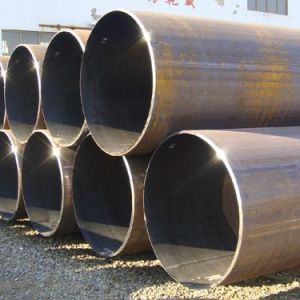Uses And Quality Inspection Methods Of Straight Seam Welded Pipe
1. Definition of straight seam welded pipe
Straight seam welded pipes, steel pipes made of hot-rolled or cold-rolled steel plates or steel strip coils welded on welding equipment, are all called straight seam welded pipes. (It is named because the welds of the steel pipe are in a straight line).

2. Material of straight seam welded pipe
Commonly used domestic materials are generally Q235A, Q235B, 0Cr13, 1Cr17, 00Cr19Ni11, 1Cr18Ni9, 0Cr18Ni11Nb, 16Mn, 20#, Q345, L245, L290, X42, X46, X70, X80, etc.
Among them, X42, X46, X56, X80 and other materials are API standard materials, which are not commonly used materials for pipes in my country.
3. The use of straight seam welded pipe
Straight seam steel pipes are mainly used in water supply engineering, petrochemical industry, chemical industry, electric power industry, agricultural irrigation, and urban construction in China.
Used for liquid transportation: water supply and drainage.
Used for gas transportation: coal gas, steam, liquefied petroleum gas.
For structural purposes: as piling pipes and bridges; pipes for docks, roads, and building structures.
4. Q235B straight seam welded pipe quality inspection method
There are many quality inspection methods for Q235B straight seam welded pipes, among which physical methods are also the most commonly used inspection methods. Physical inspection is a method of measuring or inspecting using some physical phenomena. The inspection of materials or internal defects of Q235B longitudinally welded pipes generally adopts non-destructive testing methods. Current non-destructive testing includes magnetic testing, ultrasonic testing, radiographic testing, penetrating testing, etc.
4.1 Magnetic inspection
Magnetic inspection can only find defects on the surface and near the surface of the magnetic Q235B longitudinally welded pipe, and only quantitative analysis of the defects can be done, and the nature and depth of the defects can only be estimated based on experience. Magnetic inspection is to use magnetic field magnetization ferromagnetic Q235B longitudinally welded pipe to produce leakage flux to find defects. According to the different methods of measuring magnetic flux leakage, it can be divided into magnetic particle method, magnetic induction method and magnetic recording method. Among them, the magnetic particle method is the most widely used.
4.2 Penetration inspection
Penetration inspection uses physical properties such as the permeability of certain liquids to discover and display defects, including color inspection and fluorescent inspection, which can be used to inspect defects on the surface of ferromagnetic and non-ferromagnetic materials.
4.3 Radiographic inspection
Radiographic testing is a testing method that uses radiopaque material and attenuation in the material to find defects. According to the different rays used in flaw detection, it can be divided into three types: X-ray flaw detection, γ-ray flaw detection, and high-energy ray flaw detection. Because of the different methods of displaying defects, each type of radiographic flaw detection is divided into ionization method, fluorescent screen observation method, photographic method and industrial television method. Radiographic inspection is mainly used to inspect the internal flaws of Q235B straight seam welded pipe welds, such as cracks, incomplete penetration, pores, slag inclusions and other defects.
4.4 Ultrasonic flaw detection
When ultrasonic waves propagate in metals and other homogeneous media, they can be used for internal defect inspection because they reflect on the interface of different media. Ultrasonic can inspect the defects of any weldment material and any part, and can find the defect position more sensitively, but it is difficult to determine the nature, shape and size of the defect. Therefore, Q235B straight seam welded pipe ultrasonic inspection is often used in conjunction with radiographic inspection.
HSH stocks a broad range of metal materials, including aluminum, steel, stainless steel, copper and brass, and specialty metals. Also, we also sell cast fittings, cast Iron, forged fittings, cutting tools, flanges, ect. If you have any needs or questions, you can contact us.
